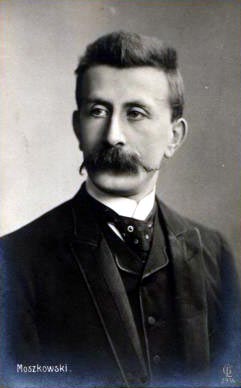Moritz Moszkowski

Born: August 23, 1854, Breslau, Prussia (now Warsaw, Poland)
Died: March 4, 1925, Paris, France
Suite for Two Violins and Piano, Op. 71
- Composed: 1903
Moritz Moszkowski was among Europe’s leading musicians during the late 19th century, a respected teacher, a noted piano virtuoso, a skilled conductor and a composer of talent and accomplishment. Moszkowski was born in Breslau of Polish-Jewish descent and trained in Dresden and Berlin. He made his debut in Berlin at age 19, and quickly became one of Germany’s leading pianists while establishing parallel careers as a teacher (at the Kullak Academy in Berlin) and composer (of a ballet, the Spanish-themed opera Boabdil, the Last Moorish King, and agreeable works for piano, orchestra, voice and chamber ensembles, of which the Spanish Dances won the greatest popularity). He toured extensively throughout Germany, England and France and, in 1897, settled in Paris, where his pupils included Wanda Landowska and Joaquín Turina. World War I ruined his investments in German and Austrian securities, and he fell into dire financial straits and poor health. In 1921, his friends living in America — Harold Bauer, Ossip Gabrilowitsch, Percy Grainger, Josef Lhevinne and 10 other celebrated pianists — gave a benefit concert at Carnegie Hall in New York, and the $10,000 they raised did much to ease the last years of Moszkowski’s life before his death in Paris in 1925.
An energetic main theme, whose motives are carved principally from falling scale steps, opens Moszkowski’s Suite for Two Violins and Piano. The formal second subject is marked by a series of quick, staccato chords from the piano, which the violins counter with fragments of the descending main theme. Further developmental discussion of these motives fills the center of the movement and leads directly to the recapitulation of the second theme, here extended. The main theme, elaborately decorated by the violins, returns as a brilliant coda. The second movement is gracious and lightly swaying, rather like a minuet. The Lento is lyrical and gently wistful. The virtuosic finale recalls the frenetic tarantella, the traditional Italian dance whose exertions were said to rid the body of the poison of the tarantula spider’s deadly bite.
© Dr. Richard E. Rodda